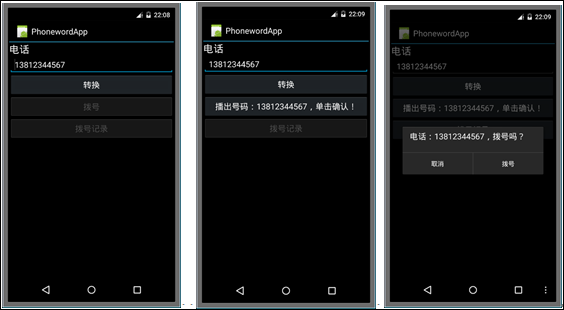編輯:關於Android編程
與onMeasure過程類似,ViewGroup在onLayout函數中通過調用其children的layout函數來設置子視圖相對與父視圖中的位置,具體位置由函數layout的參數決定,當我們繼承ViewGroup時必須重載onLayout函數(ViewGroup中onLayout是abstract修飾),然而onMeasure並不要求必須重載,因為相對與layout來說,measure過程並不是必須的,具體後面會提到。首先我們來看下View.java中函數layout和onLayout的源碼:
[java]
public void layout(int l, int t, int r, int b) {
int oldL = mLeft;
int oldT = mTop;
int oldB = mBottom;
int oldR = mRight;
boolean changed = setFrame(l, t, r, b);
if (changed || (mPrivateFlags & LAYOUT_REQUIRED) == LAYOUT_REQUIRED) {
if (ViewDebug.TRACE_HIERARCHY) {
ViewDebug.trace(this, ViewDebug.HierarchyTraceType.ON_LAYOUT);
}
onLayout(changed, l, t, r, b);
mPrivateFlags &= ~LAYOUT_REQUIRED;
ListenerInfo li = mListenerInfo;
if (li != null && li.mOnLayoutChangeListeners != null) {
ArrayList<OnLayoutChangeListener> listenersCopy =
(ArrayList<OnLayoutChangeListener>)li.mOnLayoutChangeListeners.clone();
int numListeners = listenersCopy.size();
for (int i = 0; i < numListeners; ++i) {
listenersCopy.get(i).onLayoutChange(this, l, t, r, b, oldL, oldT, oldR, oldB);
}
}
}
mPrivateFlags &= ~FORCE_LAYOUT;
}
函數layout的主體過程還是很容易理解的,首先通過調用setFrame函數來對4個成員變量(mLeft,mTop,mRight,mBottom)賦值,然後回調onLayout函數,最後回調所有注冊過的listener的onLayoutChange函數。
對於View來說,onLayout只是一個空實現,一般情況下我們也不需要重載該函數:
[java]
protected void onLayout(boolean changed, int left, int top, int right, int bottom) {
}
接著我們來看下ViewGroup.java中layout的源碼:
[java]
public final void layout(int l, int t, int r, int b) {
if (mTransition == null || !mTransition.isChangingLayout()) {
super.layout(l, t, r, b);
} else {
// record the fact that we noop'd it; request layout when transition finishes
mLayoutSuppressed = true;
}
}
super.layout(l, t, r, b)調用的即是View.java中的layout函數,相比之下ViewGroup增加了LayoutTransition的處理,LayoutTransition是用於處理ViewGroup增加和刪除子視圖的動畫效果,也就是說如果當前ViewGroup未添加LayoutTransition動畫,或者LayoutTransition動畫此刻並未運行,那麼調用super.layout(l, t, r, b),繼而調用到ViewGroup中的onLayout,否則將mLayoutSuppressed設置為true,等待動畫完成時再調用requestLayout()。
上面super.layout(l, t, r, b)會調用到ViewGroup.java中onLayout,其源碼實現如下:
[java] view plaincopy
@Override
protected abstract void onLayout(boolean changed,
int l, int t, int r, int b);
和前面View.java中的onLayout實現相比,唯一的差別就是ViewGroup中多了關鍵字abstract的修飾,也就是說ViewGroup類只能用來被繼承,無法實例化,並且其子類必須重載onLayout函數,而重載onLayout的目的就是安排其children在父視圖的具體位置。重載onLayout通常做法就是起一個for循環調用每一個子視圖的layout(l, t, r, b)函數,傳入不同的參數l, t, r, b來確定每個子視圖在父視圖中的顯示位置。
那layout(l, t, r, b)中的4個參數l, t, r, b如何來確定呢?聯想到之前的measure過程,measure過程的最終結果就是確定了每個視圖的mMeasuredWidth和mMeasuredHeight,這兩個參數可以簡單理解為視圖期望在屏幕上顯示的寬和高,而這兩個參數為layout過程提供了一個很重要的依據(但不是必須的),為了說明這個過程,我們來看下LinearLayout的layout過程:
[java]
void layoutVertical() {
……
for (int i = 0; i < count; i++) {
final View child = getVirtualChildAt(i);
if (child == null) {
childTop += measureNullChild(i);
} else if (child.getVisibility() != GONE) {
final int childWidth = child.getMeasuredWidth();
final int childHeight = child.getMeasuredHeight();
……
setChildFrame(child, childLeft, childTop + getLocationOffset(child),
childWidth, childHeight);
childTop += childHeight + lp.bottomMargin + getNextLocationOffset(child);
i += getChildrenSkipCount(child, i);
}
}
}
private void setChildFrame(View child, int left, int top, int width, int height) {
child.layout(left, top, left + width, top + height);
}
從setChildFrame可以看到LinearLayout中的子視圖的右邊界等於left + width,下邊界等於top+height,也就是說在LinearLayout中其子視圖顯示的寬和高由measure過程來決定的,因此measure過程的意義就是為layout過程提供視圖顯示范圍的參考值。
layout過程必須要依靠measure計算出來的mMeasuredWidth和mMeasuredHeight來決定視圖的顯示大小嗎?事實並非如此,layout過程中的4個參數l, t, r, b完全可以由視圖設計者任意指定,而最終視圖的布局位置和大小完全由這4個參數決定,measure過程得到的mMeasuredWidth和mMeasuredHeight提供了視圖大小的值,但我們完全可以不使用這兩個值,可見measure過程並不是必須的。\\
說到這裡就不得不提getWidth()、getHeight()和getMeasuredWidth()、getMeasuredHeight()這兩對函數之間的區別,getMeasuredWidth()、getMeasuredHeight()返回的是measure過程得到的mMeasuredWidth和mMeasuredHeight的值,而getWidth()和getHeight()返回的是mRight - mLeft和mBottom - mTop的值,看View.java中的源碼便一清二楚了:
[java]
public final int getMeasuredWidth() {
return mMeasuredWidth & MEASURED_SIZE_MASK;
}
public final int getWidth() {
return mRight - mLeft;
}
這也解釋了為什麼有些情況下getWidth()和getMeasuredWidth()以及getHeight()和getMeasuredHeight()會得到不同的值。
總結:整個layout過程比較容易理解,一般情況下layout過程會參考measure過程中計算得到的mMeasuredWidth和mMeasuredHeight來安排子視圖在父視圖中顯示的位置,但這不是必須的,measure過程得到的結果可能完全沒有實際用處,特別是對於一些自定義的ViewGroup,其子視圖的個數、位置和大小都是固定的,這時候我們可以忽略整個measure過程,只在layout函數中傳入的4個參數來安排每個子視圖的具體位置。
作者:zjmdp
 Android自定義button點擊效果的兩種方式
Android自定義button點擊效果的兩種方式
我們在界面上經常會用到button按鈕,但通常button點擊後看不到點擊的效果,如果用戶連續點擊了兩次,就會報NAR錯誤,這樣交互性就比較差了。如果我們自定義了butt
 Android ATCID客制化AT命令
Android ATCID客制化AT命令
ATCID主要用來處理PC端傳輸過來的AT命令,從AT命令實際處理的地方來說,主要分為3類: 1. 需要Modem來處理的AT命令; 2. 需
 第1個Android應用程序 Android制作簡單單頁導航
第1個Android應用程序 Android制作簡單單頁導航
本例子演示如何添加一個簡單的單頁導航,在此基礎上,再演示如何在第2個頁面中顯示第1個頁面中撥打過的所有電話號碼。(1)通過該例子理解Android App的基本架構。(2
 Android提高之MediaPlayer音視頻播放
Android提高之MediaPlayer音視頻播放
前面文章已經詳細介紹了Android界面的入門技術,相信大家在看完和跟著練習之後,會對於常用的Layout和View都會有一定的了解了,接下來就不再強調介紹界面了,而是針